A LONG JOURNEY
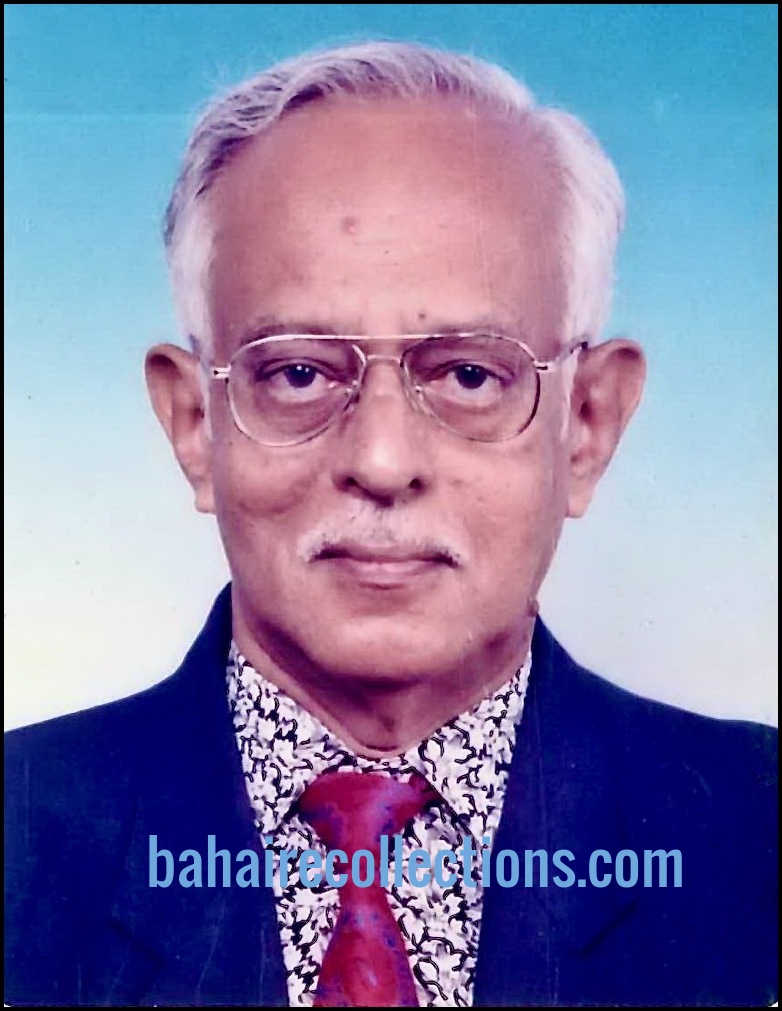
A LONG JOURNEY
I could only thank Bahá’u’lláh with all my heart for keeping me firm and steadfast since I accepted the Faith in 1961. To write everything that happened during these 60 years of my Bahá’í life is not easy. I am presenting some important incidents and anecdotes to the extent I am able to recollect.
I was born in Ipoh on 10 October 1938. My early education was in a Tamil school, but from my second year onwards I was educated in English when my parents got me registered into the Anglo Chinese School in Sungai Siput town. After clearing my Cambridge Overseas School Certificate in 1958 with “A” level pass, I managed to get a temporary post as an English teacher in a Tamil school. After working there for six months I took up another job as a temporary Postal Clerk in Kuala Lumpur in early 1960.
My spiritual journey started in January 1960. While I was working as a there, an Indian youth approached me to talk to me about a new religion. I refused to give a listening ear as I felt that the presence of too many religions was the cause of so many conflicts and contentions in the world. That Indian youth then recommended a book to read, but I refused totally.
Next I was offered a permanent job as a clerk with the same Postal Department in Kuala Lumpur. I went to the Federal Establishment Office and requested for a posting to Ipoh, my native town. Since there was no vacancy in Ipoh I was told to wait. After repeated visits the answer was the same- no vacancy in Ipoh.
One day while I was walking along the Brickfields street in Kuala Lumpur, and to my surprise I met my classmate Mr. M.S. Maniam from the Anglo Chinese School in Sungai Siput. He was undergoing a course as a Trainee Teacher in Seremban town in the state of Negeri Sembilan. When I told him of my difficulties in getting a posting to Ipoh town he asked me to consider posting to Seremban and offered me accommodation. I agreed and the next day I went to the Federal Establishment Office and enquired whether there was any vacancy in Seremban. As there was a vacancy in Seremban I was given a letter of appointment to report to the Public Works Department in Seremban. I reported for work on 15 January 1960.
In Seremban, I stayed with my classmate M.S. Maniam who rented a room above one Thevar Restaurant. Another youth by the name of R. Mariappan was visiting M.S. Maniam. In introducing Mariappan M.S. Maniam said, “He always talks about a new religion called the Bahá’í Faith.” It flashed in my mind that this may be the same religion that an Indian youth wanted to talk to me while I was working in Kuala Lumpur. Whenever Mariappan came to see M.S. Maniam, he relentlessly talked about the Bahá’í Faith. He even invited us to the Bahá’í Centre at 333, Rahang Road, which was the house owned by Yankee Leong, the first believer of Malaya. Volumes could and should be written about him.
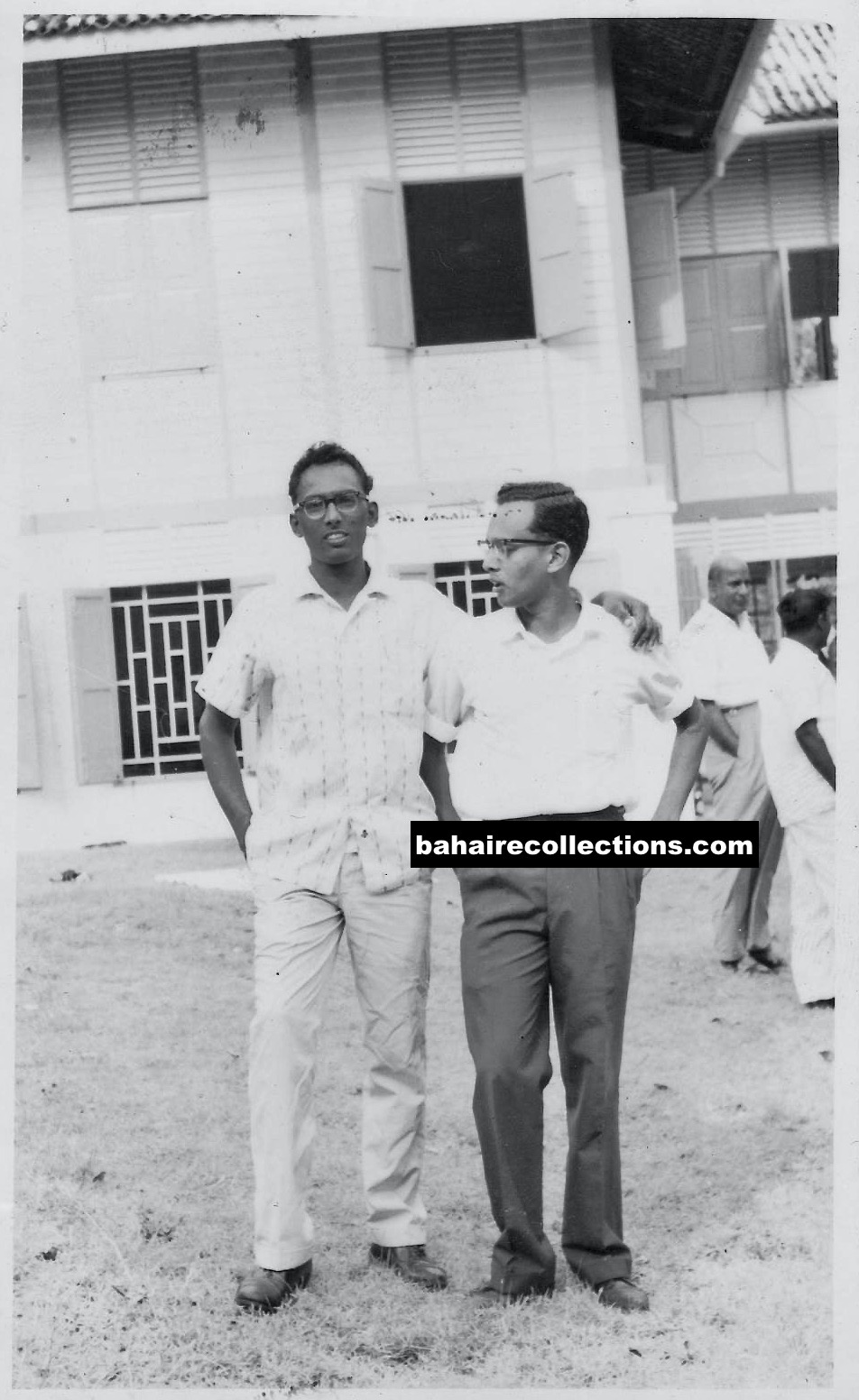
Seremban 1961,Mariappan at left and Krishnan at right
It was during one of such visits to the Bahá’í Centre that I met Hand of the Cause of God Dr. Raḥmatu’lláh Muhájir, and many others early stalwarts like Dr. Chellie John Sundram and his wife Mrs. Shantha Sundram, Mr. Leong Tat Chee and Mrs. Shirin Fozdar. None of them compelled me into accepting the Faith, but they lovingly guided me through the healing message of Bahá’u’lláh. I attended Bahá’í meetings in the Bahá’í Centre for almost 2 years and was gathering more information on the Bahá’í Faith. I found the teachings resistless and very meaningful to my own way of thinking. Yankee Leong and his daughter Ms. Lily Ng too had played a major part in my acceptance of the Faith. Lily Ng was working as a Stenographer in the Public Works Department in Seremban where I too worked, and she would talk about the Faith at every opportunity.
Towards the end of 1961, Dr. Muhájir visited Yankee Leong. Mariappan invited M.S. Maniam and me to meet him. Dr. Muhájir greeted us with his broad smiling face and gave me a hug and said a few comforting words. I just cannot describe that strange feeling of warmth I got from that hug. I returned home with so many pleasant thoughts flashing in my mind. While lying on my bed I recollected all that happened in that meeting, especially the touching words of Dr. Muhájir and his friendly and warm hug. I related this strange feeling to my friend M.S. Maniam, and to my surprise, he too felt the same. There was no more doubt to be cleared after these two years of investigating. That night I thought I should not tarry any further and decided to accept the Blessed Beauty Bahá’u’lláh as the Manifestation of God for this age. The following day, M.S. Maniam and I went to Yankee Leong’s house and signed the Bahá’í declaration card. Just as I signed in the declaration card, this verse from a prayer by Bahá’u’lláh flashed into my mind: “Whomsoever Thou willest Thou causest to draw nigh unto the Most Great Ocean, and on whomsoever Thou desirest Thou conferrest the honor of recognizing Thy Most Ancient Name.” I was clear in my mind that it was Bahá’u’lláh who had caused me to draw nearer to Him when I was trying to avoid His message. I could see clearly why my attempt to get posting to Ipoh had never worked out. As soon as I signed up the Bahá’í declaration card, Dr. Muhájir gave me a prayer book which I still preserve to this day. The date of my declaration could be end of 1961.
After having accepted the Faith, M.S. Maniam and I went out for teaching, mainly to the Tamil speaking areas. During this period, an English Army Officer named Major Harry Charles who was with the British Army in Seremban accepted the Faith and generously donated his car to the Local Spiritual Assembly of Seremban. We drove this car for teaching to the nearby estates.
During Riḍván 1962, I was elected as a member of the Local Spiritual Assembly of Seremban, and that was a great opportunity for me to learn of the God-given spiritual institution. Serving on the Assembly was a new experience to me, as I could compare and contrast a divine institution against man-made associations and organizations. How could it be otherwise when the Local Spiritual Assembly is divinely ordained?
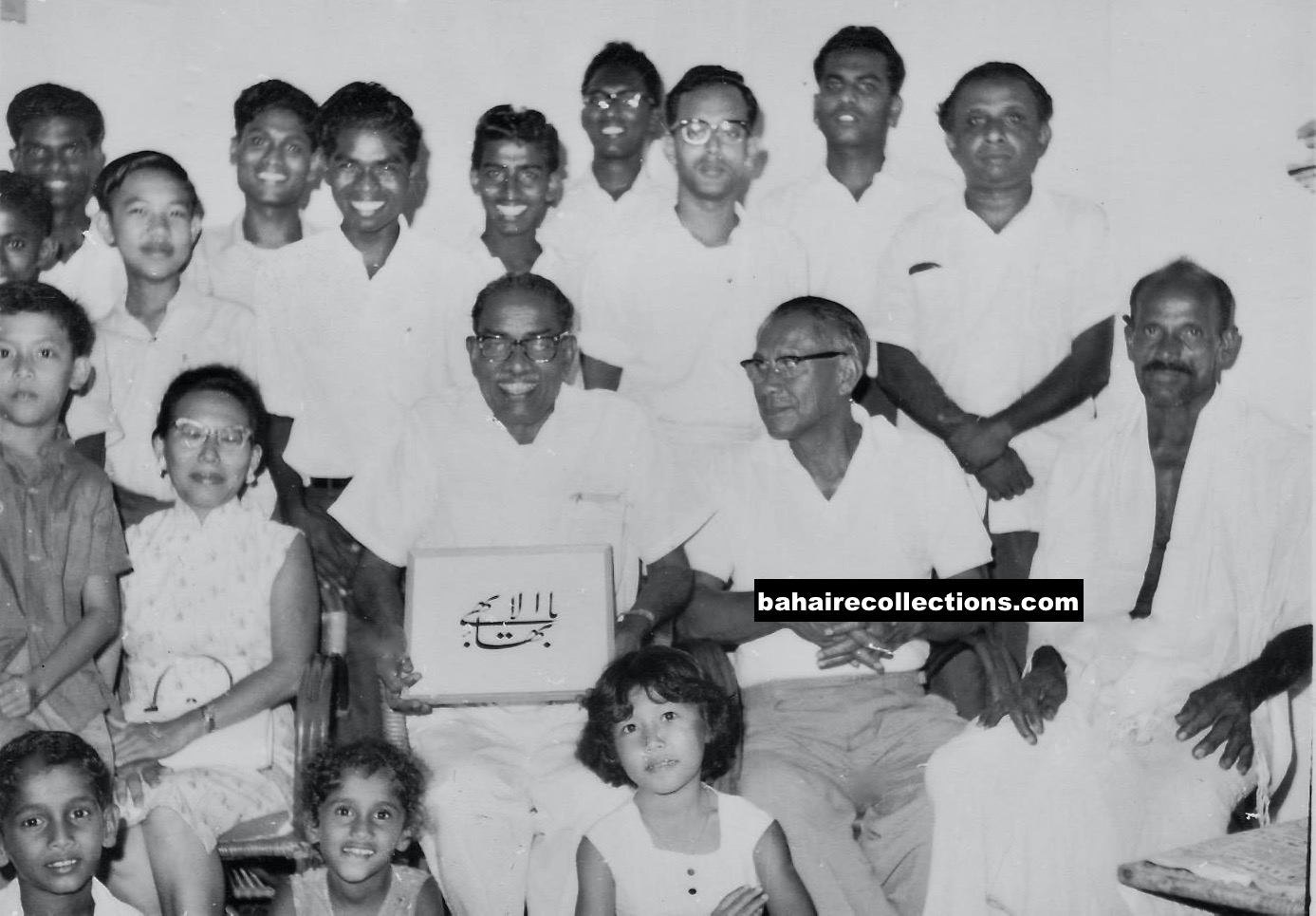
Gathering in Seremban Bahá’í Centre, 1962. L-R- Francis Ng, Lily Ng, K. Rajah, Poh Eng Siew. Krishnan is at the back and between K. Rajah and Poh Eng Siew.
On 15 November 1962, I got a transfer to the Medical Department in Ipoh town. Yankee Leong who had been traveling to several places to teach the Faith had also visited Ipoh. He told me that there were some believers in Ipoh in 1961 and gave me a list of their names. One of them was Mirinal Kanti Paul from Malacca who was residing in Ipoh for two years from 1958. He was the headmaster of Ipoh Tutorial Centre until 1962. Mirinal took the initiative to arrange for public talks whenever Mrs. Shirin Fozdar came to Ipoh. In the first two years, Mirinal was in Ipoh he arranged three public talks in Ipoh for Mrs. Shirin Fozdar. Mirinal was staying in Y.M.C.A and had an old Morris Minor car which was extensively used for teaching activity. One evening, we went to Teluk Intan town, formerly known as Teluk Anson in Mirinal’s car. As it was raining heavily and the visibility was poor, the car hit some obstacles by the roadside and the rear mudguard came off and the car stalled. Fortunately, we found a rope to tie the mudguard and continued the journey to Teluk Intan. We went to meet Mr. Stanley Foo Boon Kiat, a Bahá’í who later went to Christmas Island in Australia for pioneering. I would say that was my earliest field work in Ipoh. Sadly, Mirinal did not stay on in Ipoh for too long.
After settling down in Ipoh, I started to look for other Bahá’ís from the list that Yankee Leong had given. To my pleasant surprise some of them were working in the same office with me in the Medical Department and one of them was Mr. Jaybal. Mr. Jaybal offered his house to hold Bahá’í meetings. Although his house was very small, firesides and other activities were held quite comfortably here.
In 1963, Mr. Chee Ah Kin, a Technician in the Public Works Department in Alor Star was transferred to Ipoh on promotion in-charge of water works. He was staying at the Y.M.C.A and became an added asset to the community.
As these activities were going on, Mr. Tony Fernandez, Assistant Superintendent of Police in Malacca was also posted to Ipoh Police Headquarters temporarily in mid-1963, awaiting his final posting to Bagan Serai town as Officer-in-Charge of Police Department in Krian district. Although his tenure in Ipoh was temporary, he and his wife Betty were invaluable assets to the Faith in Ipoh town and the state of Perak as well. When I met him at his Police Headquarters, he was keen to learn of the activities in Ipoh. As soon as Tony settled down in Ipoh, he taught the Faith to some police officers and two of them accepted the Faith. One of them was Police Inspector Mr. Rogers Sammy Chung and the other one was Senior Special Branch officer Mr. Rathakrishnan. Soon Radhakrishnan’s wife Rani too accepted the Faith.
The Bahá’í population flourished, and we were getting visits from more enquirers. And Mr. Jaybal’s house was not able to accommodate the high numbers of believers for meetings. As his house was small, many had to stand outside to listen to the talks. Mrs. Rani, the wife of Inspector Rathakrishnan offered her spacious hairdressing saloon called “Pushpa Raya Beauty Saloon” at 82 Jalan Yang Khalsom for Bahá’í gatherings in the evenings, after the business hours. Rani was the younger sister of Tan Sri Jayaratnam, a very famous lawyer and President of the Perak Turf Club and a renowned philanthropist.

Gathering at Rani’s Hair Dressing Saloon, Ipoh. Seated R-L: Yeoh Chai Lye, K. Krishnan, Yankee Leong, Tony Fernandez, Rani Rathakrishnan. Standing right at the back of Yankee Leong is Radhakrishnan. Standing third from left is Rogers Sammy Chung, with Sidambaram to his right. Standing third from right is Chee Ah Hin.
In Riḍván 1963 the Local Spiritual Assembly of Ipoh was elected with Mr. Rogers Sammy Chung as the Chairman, Inspector Rathakrishnan as Vice Chairman, Mr. Chee Ah Hin as the Treasurer, and I as Secretary. Many years later we were happy to read from the Bahá’í World, Volume XIII which mentioned that the first Local Spiritual Assembly of Ipoh was elected in 1963. At the time of the election of the first Local Assembly of Ipoh we never gave a thought that we were creating history.
In December 1963, Mrs. Theresa Chee, a teacher from Alor Star and wife of Mr. Chee Ah Hin came on transfer to Ipoh. They rented a house in Canning Garden. Her coming to Ipoh was a new beginning for the Faith and the community. She was the greatest mover of activities in Ipoh since her arrival there. All the activities were shifted from Rani’s hairdressing saloon to the residence of Mrs. Theresa Chee. Thenceforth, activities accelerated and many outstation Bahá’ís, such as Yankee Leong of Seremban, Leong Tat Chee of Malacca and Dr. Chellie Sundran and his wife Mrs. Shantha Sundram of Penang came to give a helping hand to further support and strengthen the Ipoh community.
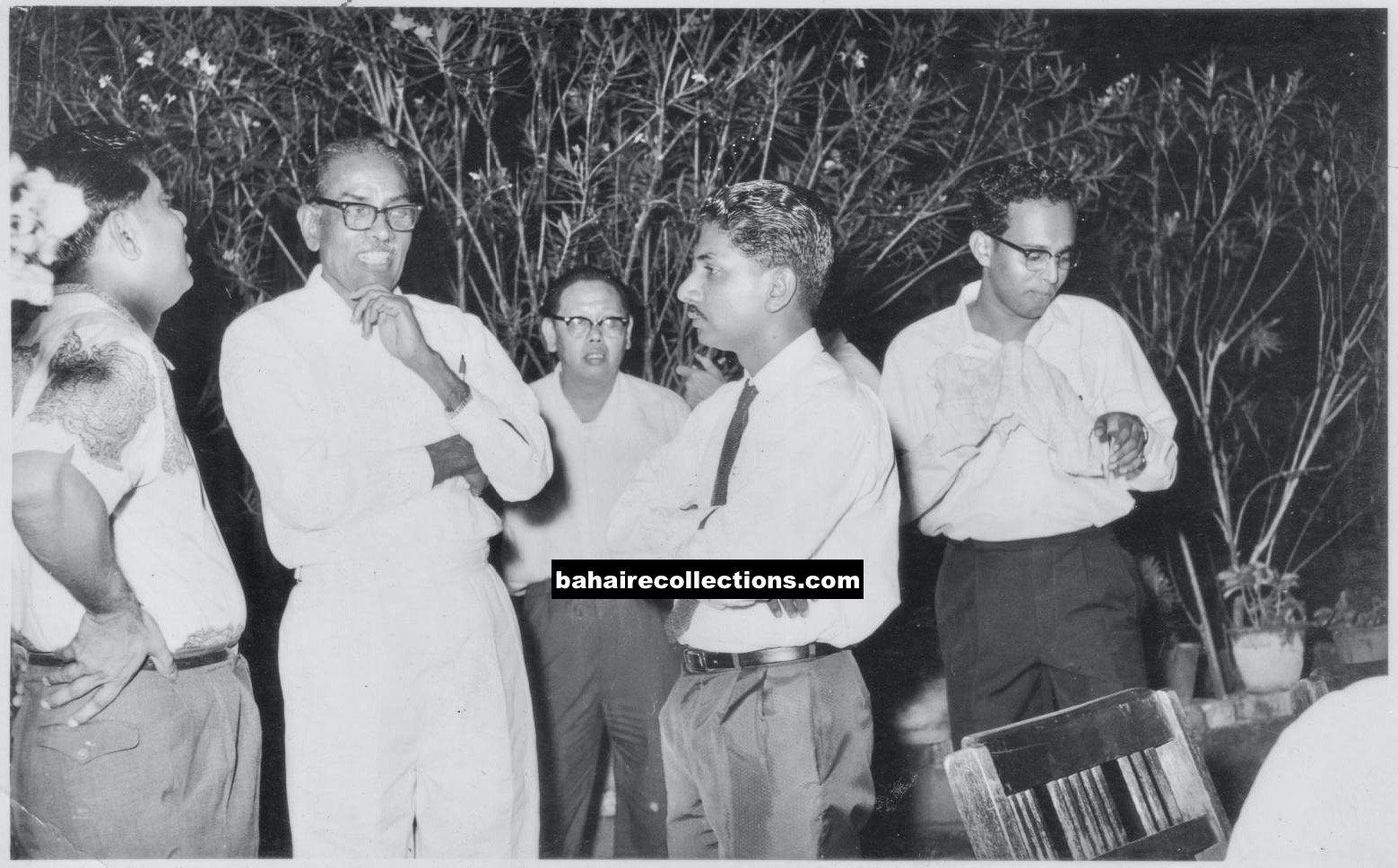
Gathering at Mr Rathakrishnan’s house. R-L: K. Krishnan, K. Nayagan (Reporter), a Chinese believer, K. Rajah from Seremban and Dr Chellie Sundram from Penang.
The one event that is etched permanently in my heart is the election of the first National Spiritual Assembly in 1964, graced by the Hand of the Cause of God Amatu’l-Bahá Rúhíyyih Khánum. It was an event to witness all the earliest workers for the Cause steadfastly coming together. The highlight was the guidance and advice Amatu’l-Bahá gave the believers and some inspiring stories she related. The atmosphere was highly charged, and it has found a permanent place in my heart to this day. I was lucky to have witnessed the rare and highly defining moment in our history.
Of all areas of service, field teaching was my passionate activity then. Every other evening, I went out to teach and meet the believers. Another local believer Mr. Sithambaram provided transport on his motorbike to visit the Bahá’ís and to teach the Faith. We started with the Changkat Kinding Estate, Tanjong Rambutan town, and Kota Baharu Estate near Gopeng town. Later, Local Assemblies were elected in Changkat Kinding Estate and Kota Baharu Estate. There were some Bahá’ís in Tanjong Rambutan town and Chemor Estate. In the later part of the 1960s, we organized a Tamil Teaching Conference in Chemor town and Mr. R. Ganasa Murthi was the main speaker who talked about the Bahá’í Administration.
I taught the Faith to my roommate, one Mr. Paramasivam whose home was in the nearby Sungai Siput town. When he went back to Sungei Siput, he talked to one Mr. C. Subramaniam who was a headmaster in one of the Tamil schools in that town. Mr. Subramaniam would come often all the way from Sungai Siput to Ipoh in the evenings to enquire more on the Faith from me. I shared with him whatever I knew and gave him a copy of the book ‘Bahá’u’lláh and the New Era.’ One weekend, I went to Sungai Siput for teaching activities and Mr. Subramaniam accompanied me. When we taught some enquirers, Mr. Subramaniam answered all their questions with clarity of thought and conviction. I was amazed with his convincing answers, although he had not signed the declaration card as a Bahá’í. When I quietly asked him why he had not signed up, he retorted that I was the one who did not give him such a card to sign. I was taken aback and gave him the declaration card which he signed and returned to me immediately. On his own initiative he started teaching the Faith in Sungai Siput and the nearby estates, such as Heawood Estate, Kemiri Estate, Changkat Salak Estate and Plang Estate. As the response was overwhelming, the Local Spiritual Assembly of Ipoh decided to organize the first Tamil Teaching Conference in Sungai Siput. The conference was held in the Sungai Siput Town Hall in 1966, with about one hundred people attending. Among the speakers was Mrs. Shantha Sundram, who spoke in English which Mr. Paramasivam, a non-Bahá’í and my roommate in Sungei Siput translated into Tamil. At the end of the conference, 21 people accepted the Faith. With the efforts of Mr. C. Subramaniam, Local Spiritual Assemblies were elected in Sungai Siput town, Changkat Salak Estate and Plang Estate. Later the entire family of Mr. Subramaniam accepted the Faith.

Mr. C. Subramaniam of Sungei Siput.
Once Mrs. Theresa Chee, Mr. C. Subramaniam, and a few of us went to Sitiawan for a day long teaching. Mrs. Chee and I went to meet Chinese friends while Mr. Subramaniam and others went to teach the Tamil speaking contacts. We met Mr. Baskaran, a school bus owner and one Mr. Krishnan, a book stall keeper who accepted the Faith earlier. Mr. Subramaniam and others went on to teach the Faith at Sungai Wangi Estate and Buluh Akar Estate.
When Tony Fernandez was settled in Bagan Serai town, he had some contacts in Kuala Kurau Estate. He wanted some Tamil speaking Bahá’ís to visit this estate. Mr. C. Subramaniam and I visited this estate, where there the former was the key speaker.
An important even in my life was my marriage to Shantha Devi on 29 January 1966 at the Sungei Siput Town Hall. The Local Spiritual Assembly of Sungei Siput conducted the wedding. My wife Shantha Devi had been a strong supporter of the Bahá’í activities to this day.
In July 1966, I had the rare bounty of attaining the presence of the Hand of the Cause of God, Mr. Taráz’u’lláh Samandarí who came to Ipoh with his grandson Soheil. We were all very thrilled as he was the only living Hand of the Cause who had attained the presence of Bahá’u’lláh and had also moved with ‘Abdu’l-Bahá and the Guardian of the Bahá’í Faith. Mr. Samandarí was a vibrant speaker and talked on the mission of Bahá’u’lláh. I remember the Hand of the Cause of God Mr. Collis Featherstone too had come to Ipoh.
I shall now come fast forward to the 1970s. At the end of 1972, Mr. Leong Ho Chiew of Petaling Jaya was transferred to Tapah town on promotion as Assistant Superintendent of Police of Kampar district, which was some 30 miles south of Ipoh. That was a high-ranking position in the Police Force. His coming to Perak was another milestone. Leong Ho Chiew invited the believers from Ipoh to assist him in teaching activities in Kampar area. Mrs. Theresa Chee and a few of us gave helping hand through which some Chinese friends accepted the Faith. One Mr. Ramachandran who was in the police force, his wife and children accepted the Faith. As he was very enthusiastic to teach the Faith, he printed his own version of some 500 declaration cards to be distributed. I counselled him to use the Bahá’í declaration cards given by the National Spiritual Assembly, and he complied.
Meanwhile, in 1975 a set of vibrant youth accepted the Faith in a nearby Kinta Valley Estate near Batu Gajah town. Mr. C. Subramaniam often visited them for deepening classes. He was like a “Godfather” for the youths. As a Tamil school teacher, his monthly salary was small. In spite of his meagre salary, he had a big heart to invite all the Bahá’í youths of Kinta Valley Estate for Naw-Rúz celebration in his home in Sungai Siput. He passed away on 25 December 1981 and was buried in the Hindu burial ground in Sungai Siput, but according to Bahá’í burial rites.
In the later part of 1970s, teaching campaigns too were organized in Kampar. Youths from Tanjong Rambutan and Ipoh such as Tharam Singh, Viveganathan, Selvarajoo gave their great support. From Kinta Valley Estate came Kunasegaran, Ratha and few others gathered at the Kampar bus station and divided themselves into two groups. One group went to the Indian Settlement and the other to the Chinese New Village. At the Indian settlement, some youths had confronted the Bahá’í youths and chased them out from the settlement. Woefully, Tharam Singh was punched by few youths.
I remember a Chinese Teaching Conference was held at the Hokkien Association Hall in Taiping town, since majority of the Bahá’ís there were Chinese. Mrs. Theresa Chee and others from Ipoh attended the conference. This conference was a great success.
A state level Youth Teaching Conference was held in the Double Lion Hotel in Kuala Kangsar town on 31 July 1966. Mr. Ganasa Murthi and his friend hitch-hiked from his hometown Alor Star to attend this conference. Support always come from friends from left and right for any Bahá’í activity being carried out.
In calling for the celebrations of ten years of independence from British rule in 1967, the Malaysian government called upon the plural societies in the country to devote one week for observing what was called the National Solidarity Week. While the government issued special stamps on that occasion, the various communities in Malaysia jubilantly celebrated the occasion. Seizing this opportunity, the Ipoh community joined other communities in celebrating this event in support of the much needed and always wanted solidarity that the Faith always promoted. That was one of the earliest external affairs activities for the Cause in Ipoh.
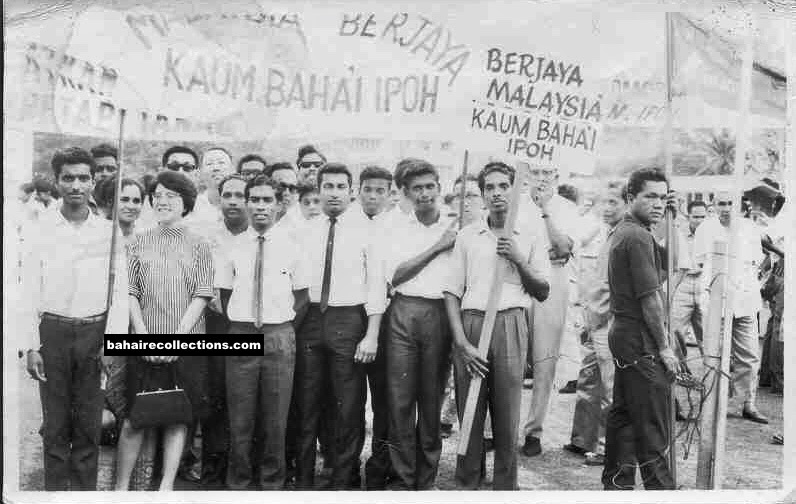
Ipoh community at the National Solidarity Week celebrations. Third from left is Mrs. Theresa Chee, with Mr. C.Subramaniam and Mr.M. Maniam to her left. Krishnan is partly hidden at the back of Maniam. Mr. Chee Ah Hin is at the back of C. Subramaniam.
Regrettably, I was not active for about 6 years from 1967 to 1973. I had unknowingly made some minor mistakes in the day-to-day administration work. Yankee Leong met me in Ipoh in 1967 and advised me as to how the Bahá’í Administration had to be handled. I felt remorse about these mistakes. After this, I did not attend any meetings or Bahá’í gatherings, as my guilt killed me for not living up to the standard of this God-given Cause of utmost purity. Keeping away too was killing me.
Meanwhile, on 15 November 1973, I was transferred on promotion to Public Works Department workshop in Kuala Lumpur. I worked there for some time but was once again transferred back to Perak on my request on 15 November 1974. This time I was posted to Hospital Bahagia in Tanjung Rambutan as a Chief Clerk. Hospital Bahagia is the largest psychiatic hospital in Malaysia. I was staying with my family in Chemor town and commuting daily to Tanjung Rambutan for work. On the advice of Mrs. Theresa Chee, I started to deepen the believers in Tanjong Rambutan. A non-believer Mr. Vadivelu was staying at the government quarters with me. The believers here met at Mr. Vadivelu’s house. Later as more Bahá’ís and inquirers started coming for the meetings, this house was found to be too small to accommodate the crowd. Mr. K.K. Krishnan, another Bahá’í staying at the government quarters volunteered to allow Bahá’í gatherings in his bungalow. Mr. R. Ganasa Murthi was invited to deliver a talk at a fireside which was well attended. After the meeting, I told Ganasa Murthi that some of those at the fireside became Bahá’ís thinking that it is a “unity movement.” He told me not to worry as from this crowd we will get the cream. How right was he. From this group we were able to elect the Local Spiritual Assembly of Tanjong Rambutan in the later part of 1970s. Among the members were Mr. Vadivelu, Mr. Maruthai, Mr. and Mrs. Maniam, Mr. Subramaniam, and me.
The Local Spiritual Assemblies of Ipoh and Tanjong Rambutan collaborated and celebrated Ayyám-i-Há with the inmates of Hospital Bahagia in 1979. A very lively concert was organized. One Mrs. Shirly Ong, who was a schoolteacher, coordinated the social event for the night and brought along her students to perform songs and dances. The music was provided by the Hospital Bahagia band. It was graced by Dr. Quek, the Acting Director of Hospital Bahagia and brought good publicity for the Cause. He was all praises for the community for bringing joy and happiness to those inmates.

Ayyam-i-Ha celebrations at Hospital Bahagia, Tanjong Rambutan.
On 16 July 1978, Mr. Y. Mari joined service in Hospital Bahagia in Tanjong Rambutan. As I was the Secretary of the Local Spiritual Assembly and State Teaching Committee for many years, much typing of the minutes of the meetings, letters and annual reports had to be accomplished. Mari typed all these letters unflinchingly, to enable me to carry out my responsibilities satisfactorily—and for this I must earnestly thank him.
My family transferred its residence to Ipoh in 1979 and I was happy to be involved in local activities in the company of some of the most wonderful believers of Ipoh. I was elected to the Local Spiritual Assembly during Riḍván election in 1981 and became its Secretary. Ipoh community had carried out some external affairs activities in which I was called upon to assist, and these are among the activities that remain raw and vivid in my mind. While some activiites were carried out by the Local Spiritual Assembly, some individual believers also had carried out merritorois services in the area of external affairs and won the admiration of the wider world. The National Spiritual Assembly requested the Local Spiritual Assembly of Ipoh to observe the United Nation’s Day in a befitting manner. Heeding to the call a public talk was organized on 21 October 1981 at the Tun Razak Library. The speakers were Ms. Doreen Chee and Mr. R. Kaniappan. A big banner placed in front of the library gave wide publicity to the event. That was the first event of its kind ever organized.
The United Nations had designated the year 1986 as the International Year of Peace. That was the year when the Universal House of Justice all the communities to distribute the “Promise of World Peace” statement to all the leading figures. The Ipoh community too engaged heavily in distributing that weighty document to the leaders. Leong Ho Chiew in his capacity as Assistant Superintendent of Police and living in Kampar gave a helping hand to the community in creating inroads to the upper brackets. He joined Theresa Chee and me in presenting the statement to the Secretary of the Perak State Government.
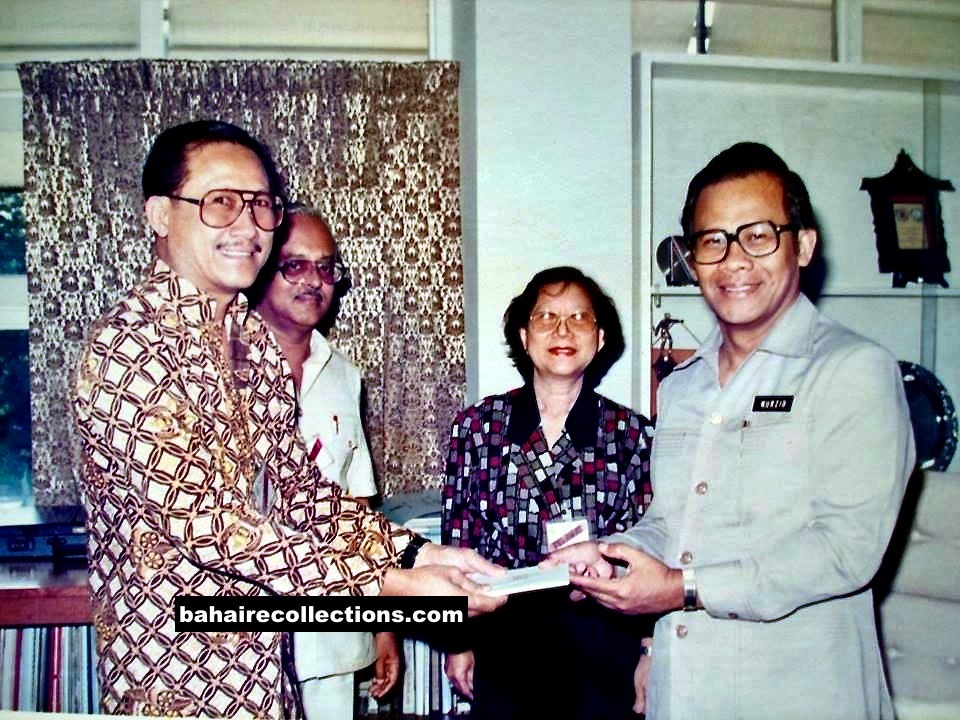
Leong Ho Chiew, left, presenting the Peace Statement to the State Secretary of Perak, with K. Krishnan and Mrs. Theresa Chee at the back.

Local Spiritual Assembly of Ipoh, 1988. Seated L-R: R. Kanniappan, Doreen Chee, Vasudevan. Standing L-R: Tan Boon Tin, Vijayasegaran, Y. Mari, Arumugam, K. Krishnan and Bernard Ong.
In 1993, the Local Spiritual Assembly of Ipoh organized another event in conjunction with United Nation’s Day. This time it was a concert called “Rhythm for Peace” held at Red Crescent Hall on 23 October 1993. The concert was officiated by Senior Executive Councilor member representing the Chief Minister of Perak. We invited the children from a home of the handicapped for the concert. Dr. Sreedharan represented the National Spiritual Assembly.
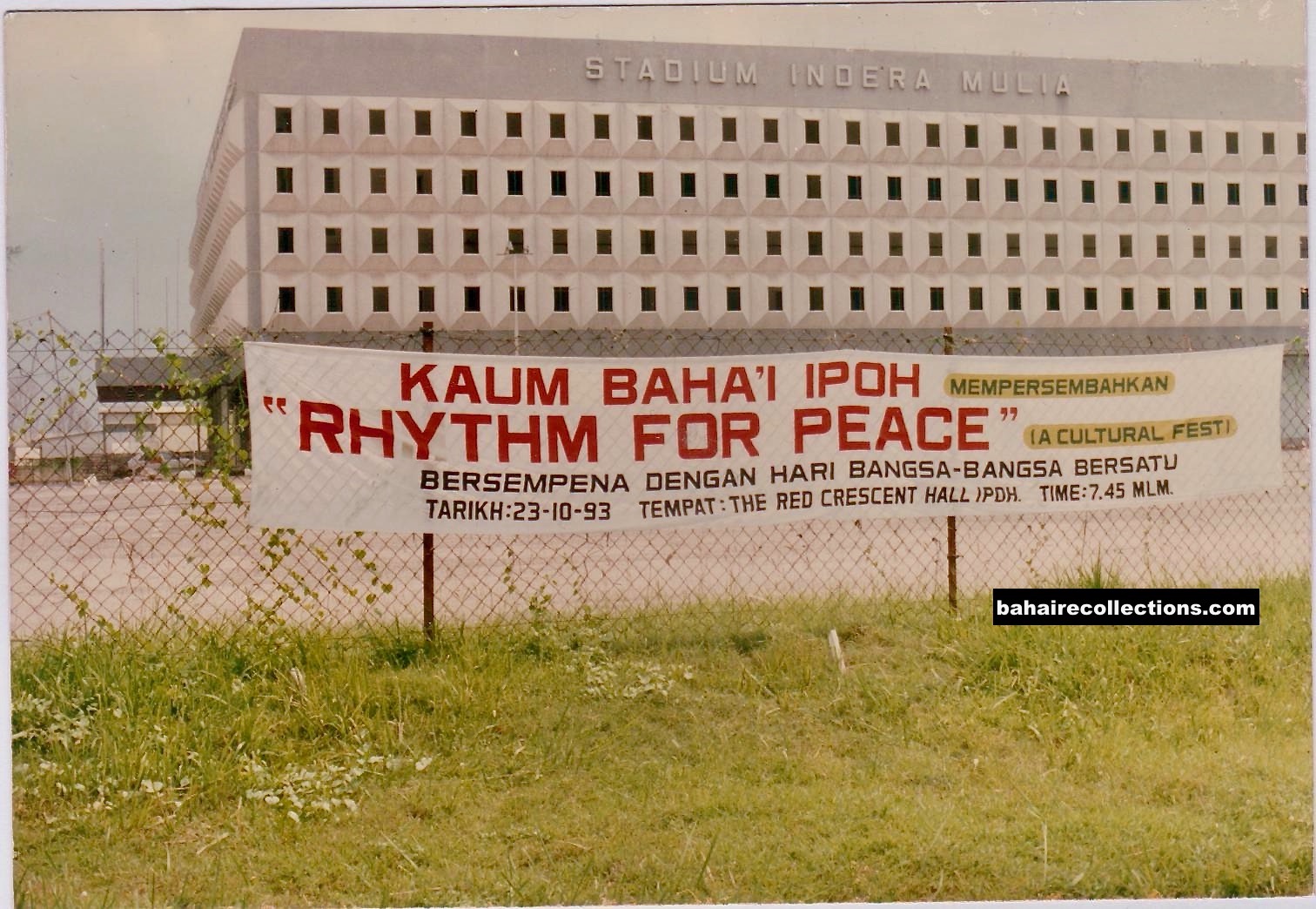
“Rhythm For Peace” banner at Stadium Indera Mulia, Ipoh that attracted much publicity.
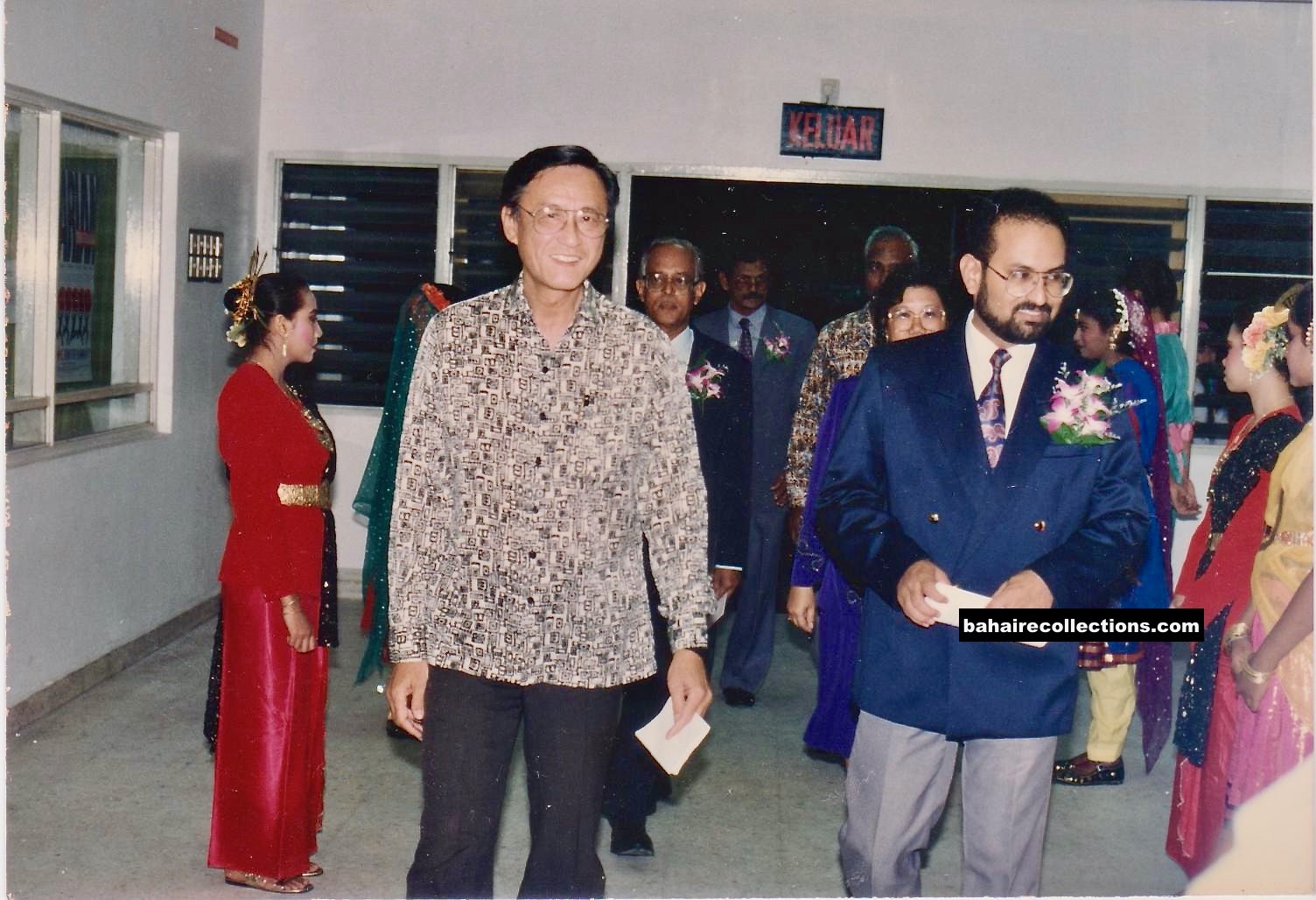
Mr Vijayasegaran ushering the representative of the Chief Minister of Perak
The National Spiritual Assembly launched the East Coast Teaching Plan and requested Local Spiritual Assembly of Ipoh to send volunteers to East Coast, mainly to Terengganu and Kelantan. Mr. N. Perumal, Mr. R. Kaniappan, Mr. Mayalagan, Mr. Y. Mari, and I went for a week to these states. We went to Kemaman town and met Dr. Ratnam. He advised us to go to Kuala Terengganu. On the way to Kuala Terengganu, we stopped at Paka, Dungun where Mr. Selvarajoo was working. Paka then was a small town and most of the residents were Malays to whom we were not to talk about the Faith then. So, we left for Kuala Terengganu where my friend had a restaurant and spent the night there. We came to know that there were a few families staying in the National Electricity Board quarters. We taught the Faith to a few and some of them told us that a few people came earlier and spoke about the Faith. We spent one whole day visiting all the Indian families in Kuala Terengganu town. The next day, we went to Kuala Berang town. Most of the residents were Chinese. As we could not speak the Chinese language, we distributed to them pamphlets in the Chinese language.
Local Teaching Committees were formed set up in and around Ipoh town—Tanjong Rambutan, Buntong, Ipoh and Menglembu, Bercham and Jelapang which accelerated teaching activities, Nineteen Day Feasts, contribution to Bahá’í Fund, children’s classes, opening of more areas to the Faith involvement of more Bahá’ís in our activities. By this time many of us had own cars which were used for the weekly teaching activities. When the local residents saw my car at a distance they will loudly say, “Bahá’í car is coming.” We were very successful in our teaching efforts with a number of people accepting the Faith.
Next, we needed a place to meet these people and we rented a place. Though Jelapang was a new community, all normal activities like Nineteen Day Feasts, children’s classes, contribution of the fund were going on. Mrs. Suppiah’s daughter Indra volunteered to teach the children and Mr. N. Perumal would ferry her every Sunday. About 10 to 15 children were attending the class. But, later with the pressure from some ill-informed people, the children stopped coming for the classes and other activities started to dwindle. After some time, the Local Teaching Committee of Jelapang too lapsed. Yet activities in other Local Teaching Committee areas were improving. The number of Bahá’ís attending the prayer meetings, contributing to Bahá’í Fund and so on progressively increased.
With the government recognizing the Faith as an independent religion, Assistant Registrars of Marriages were appointed to conduct Bahá’í civil marriages. Mr. Loh Ghee Juan, being the Chairman of the Local Spiritual Assembly and I as the Secretary were appointed as Assistant Registrar of Marriages. I served as Assistant Registrar of Marriages for about twenty years and performed about 80 marriages. Many children produced from these marriages are serving the Cause effectively till this day. I consider that as a great bounty conferred upon me by the Blessed Beauty.
Acquisition of burial ground was a very tedious task. The Local Spiritual Assembly applied for a burial ground plot when one of the late Mr. Seenivasagam’s brothers was the Mayor of Ipoh Municipality. Sadly, there was no follow up. After a few years, the Local Spiritual Assembly submitted a fresh application to the Director of the Land Office of Perak state and followed up with several reminders. Mrs. Theresa Chee and I kept pushing the matter. The members of Local Spiritual Assembly have been attending Ramadan Festival celebrations at the Chief Minister’s official residence almost every year to convey the greetings of the Bahá’í community. On a particular year the Local Spiritual Assembly decided to bring the matter to the attention of the Chief Minister himself. Mr. Vijayasegaran spoke to the Chief Minister during a Ramadan Festival celebration. He promised to look into it, and three months later, we received a letter saying that the Executive Committee of the Perak State Government had decided to give a plot of land as a burial ground. After several follow-up meetings with the officer-in-charge of land matters in Batu Gajah town, they identified a plot of land, and we were advised to engage a private surveyor. We received the surveyor’s report and finally the approval letter was given, and the plot of land was gazetted as ‘Tanah Perkuburan Baha’i’. (Bahá’í Burial Ground).
Our joy of obtaining a dedicated burial ground was immediately put to test as one youth passed away and the parents wanted him to be buried in this burial ground. While the Local Spiritual Assembly had not consulted the terms of using the burial ground it agreed to the parent’s request. Mr. Y. Mari and Mr. Tan Boon Tin were tasked to identify the grave, which they did while other believers including Mr. Pandian, Mr. Mathi, Mr Raja Gopal, Mr Y. Mari, and Mr Ramachandran Rao dug the grave. In the Hindu community from which I came, digging of graves was the occupation assigned to the so-called low caste. But here were the Bahá’ís, coming together and dug the grave, breaking the fossilized and outlived superstitious thoughts of the past. This land that was once used for planting vegetables and was very uneven with a lot of potholes. Mr. Pandian borrowed his brother’s tractor and leveled the ground. Later, we had engaged a tractor to level the land further.

Erection of the signboard for our own burial ground.
Another historic event that the Local Spiritual Assembly did was to exhume the remains of Mr. Yankee Leong from a Chinese burial ground located at Tambun Road to be buried at the Bahá’í Memorial Park at Jalan Lahat, Ipoh. The family too wanted this relocation. There were a lot of procedures to follow for the relocation. First, the Chinese Burial Ground Committee must give its permission, followed by approval from Health Department and District Police Office. With all these approvals, we had to apply to the State Secretary of Perak for approval. After those procedures were duly complied with, the family of Yankee Leong engaged a Chinese Funeral Parlour to exhume the body and rebury it in the Bahá’í Burial Ground. This was achieved with a lot of prayers.

Exhuming the remains of Yankee Leong. L-R: Mr. Selvarajoo, Mr. Ronnie Koh, Mr. Tan Boon Tin, Mr. K. Krishnan and a news reporter.
When the Ipoh community had grown in strength, the National Spiritual Assembly requested the Local Spiritual Assembly of Ipoh to organize a National Winter School in Perak in 1996. An organizing committee was formed with all Local Spiritual Assembly members under the chairmanship of Mr. Vijayasegaran. Others were Mr. and Mrs. Ling Boo Min, and Mr. S. Krishnan and Mr. Dharmalingam from Sitiawan. The venue was the Chinese School (Private) in Air Tawar town. Accommodation was provided in the school hostel and those who could afford booked hotel rooms in the nearby Sitiawan town. We engaged a food caterer from Ipoh. About 1,400 participants from throughout the country attended the winter school, said to be one of the biggest.
Ipoh was also the venue for the celebrations of the fiftieth anniversary of the acceptance of the Faith by Yankee Leong, organized in November 2003. The Local Assembly of Ipoh put its heart and soul in organizing the event and it turned out to be a well-remembered event.
The Local Spiritual Assembly organized a forum on Drugs in collaboration with National Women Council. The forum was financed by this council, and they wanted a woman to be the organizing chairperson. Ms. Doreen Chee was the organizing chairperson. This forum was held in Hotel Excelsior in Ipoh. The speakers were, one from Ipoh General Hospital, a police officer, a welfare officer, and a representative from the Anti-Drug Agency. With the resounding success of the forum, the National Women Council requested the participants to organize similar events in other districts. One such event was held in Kuala Kangsar and the other in the Field Force in Ulu Kinta.
We had also organized Anti-Drug Campaign in YMCA. This campaign was officiated by a Senior Executive Council member of the state government and the speakers were from all agencies involved in drug rehabilitation.
When the National Spiritual Assembly appointed State Teaching Committee of Perak, I was elected as the Secretary of the State Teaching Committee. We met all the members of all Local Spiritual Assemblies in the state for discussion and for planning short and long-term activities. Whenever the Local Spiritual Assemblies requested for assistance we would try to solve their problems by asking individuals to volunteer. There was a group of Chinese contact in Lenggong town near Grik. Mrs. Theresa Chee, Ms. Doreen Tan, Mdm. Lee Lai Wah and I visited this group. They were very hospitable and very encouraging. Some of them told us that they will talk to their friends about the Faith. The members of the State Teaching Committee also visited the Local Assemblies to find out the progress and problems they encounter.
One of the notable achievements of the State Teaching Committee of Perak was organizing Summer Schools for nine years continuously. Each year it was held in different towns with the collaboration of the respective Local Spiritual Assemblies, such as Ipoh, Sitiawan, Pengkalan Ulu (Kroh), Telok Intan and Cameron Highlands. After some time, the State Teaching Committee was disbanded, with the Regional Bahá’í Council taking over such responsibilities.
I was lucky to have participated in the Second Bahá’í World Congress held in New York in 1992. On the way we went to the Bahá’í House of Worship in Wilmette, Chicago. That was a fulfilment of my pent-up desire to visit that sacred edifice of the greatest beauty. The World Congress event itself was magical and quite unbelievably astonishing. The coming together of so many races and listening to the talks of the Hands of the Cause of God Amatu’l-Bahá Rúhíyyih Khánum, Dr. ‘Alí-Muhammad Varqá and Mr. ‘Alí-Akbar Furútan still ring in my ears. That was yet one more rare gift from Bahá’u’lláh.
Cambodia was a goal country for Malaysia and travel teachers from Malaysia were sent there to teach the Faith in order to form the first National Spiritual Assembly of the Bahá’ís of Cambodia. Mr Pandian and I went for a ten-day teaching trip to Cambodia in the beginning of 1993. The National Spiritual Assembly was formed successfully in 1994. I was happy to have played a small role in my own small way.
Yet one more unforgettable event was the trip to the Holy Land for a three-day visit in the company of Mr. and Mrs. Ramanaidu and Mr. Y. Mari in April 1999. We went by way of London as Mr. Ramanaidu’s son, Leroy was studying there. We stayed in the house of Mr. and Mrs. Issac in Liverpool. We visited the resting place of our beloved Guardian in South Gate Christian Cemetery. It was a wonderful experience. From London we proceeded to the Holy Land where we had the bounty of visiting all the holy and historical sites. We have also had the bounty to celebrate together the Birthdays of the Báb and Bahá’u’lláh. Every night there was a talk by the resident Hands of the Cause of God, Mr. Ali Furutan and Dr. Muhammad Varqa. The former urged the Bahá’ís to be firm in the Covenant and not deviate from the writings of Bahá’u’lláh. Dr. Muhammad Varqa spoke about Huqúqu’lláh.
The one verse that touched me when I accepted the Faith was “WORK IS WORSHIP; SERVICE IS PRAYER”. I used this magical verse as my guiding principle in whatever work I carried out- both in the Faith or in the wider world.
While I was active in the Cause, I also got involved in activities outside the community. I got a promotion as Superscale Clerk on 1 March 1979 and designated in Hospital Bahagia as Financial Assistant in-charge of all financial matters. I held this position for 14 years until my retirement from the government service on 10 October 1993. During my service, I was recommended for Excellent Service Award four times – twice at hospital level, once at Perak state level and once at federal level – Ministry of Health. My superior was very pleased with my service, and with his recommendation I was awarded the Perak state medallion of Pingat Jasa Kebajikan (PJK) which I received from Sultan of Perak in 1981.
After retiring from the government service on 10 October 1993, I immediately took up a job as an Accounts Clerk in Perak Medical Centre, Ipoh. While I was working at the Medical Centre, I joined the Perak Society for Mental Health, also known as Day Care Centre, that cares for ex-psychiatric patients. The President of the centre pleaded with me to join her to sort out the accounts of the centre which was in a mess. I was elected as the Treasurer of the centre and have introduced some procedures to follow whenever money and or donations were received. Soon there was a lot of money in the account. In appreciation of my services the President recommended me for State awards which His Highness the Sultan of Perak will award every year during his birthday celebrations. With the recommendation of the President, I was conferred the Pingat Pekerti Terpilih (PPT) award in 2001 and Darjah Mahkota Perak (AMP) award in 2005.
These are some of the events that I managed to recollect at this ripe age of 83. I am happy that the lion’s share of my earthly life has been for the Cause of Bahá’u’lláh, and what more could I ask for? The Blessed Beauty’s unfailing bounties and protection have been overwhelming and uncountable.
Krishnan Kunchamboo
Ipoh, Perak
Malaysia
31 August 2021
Copyright @ bahairecollections.com
Comments can be posted through: info@bahairecollections.com